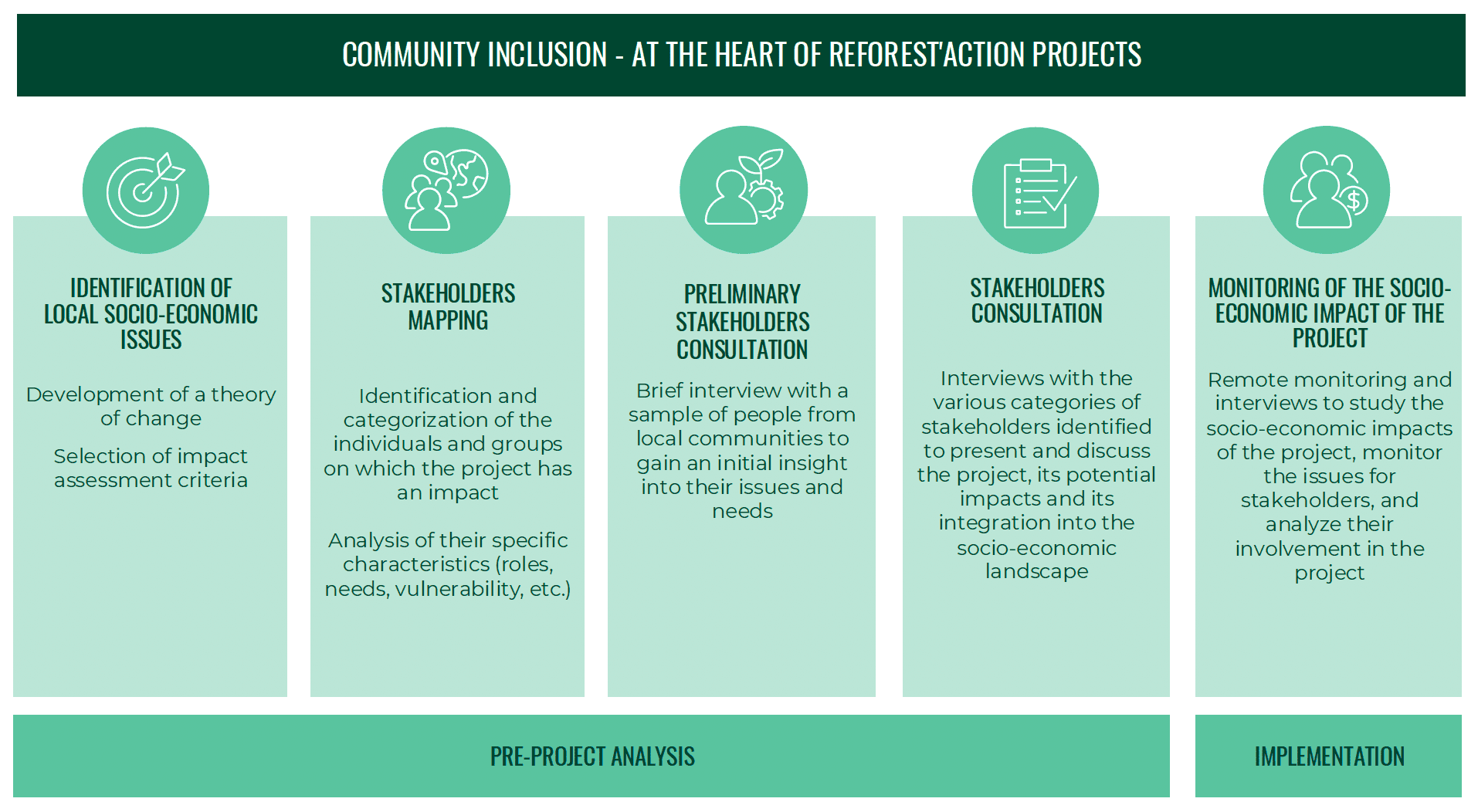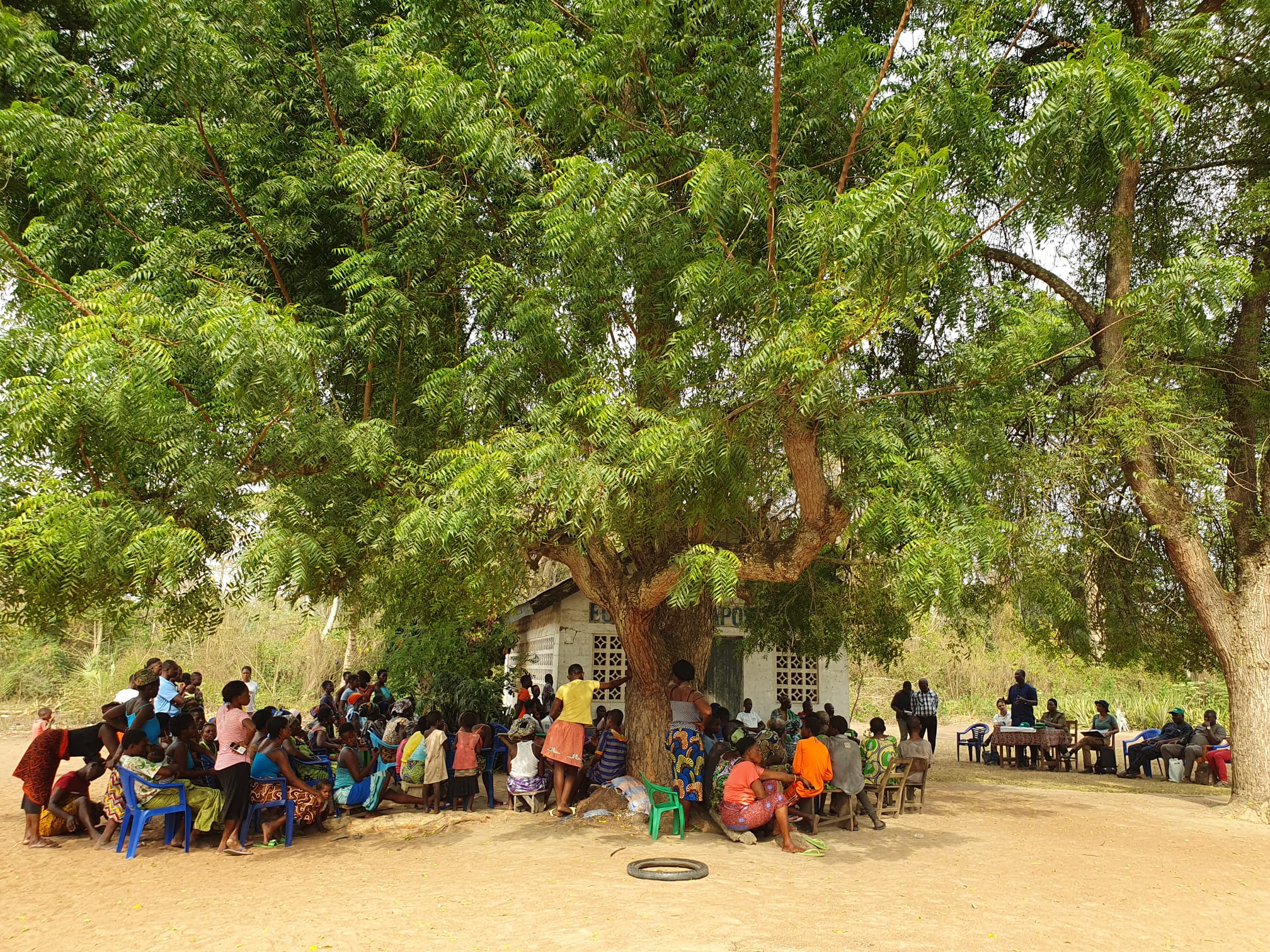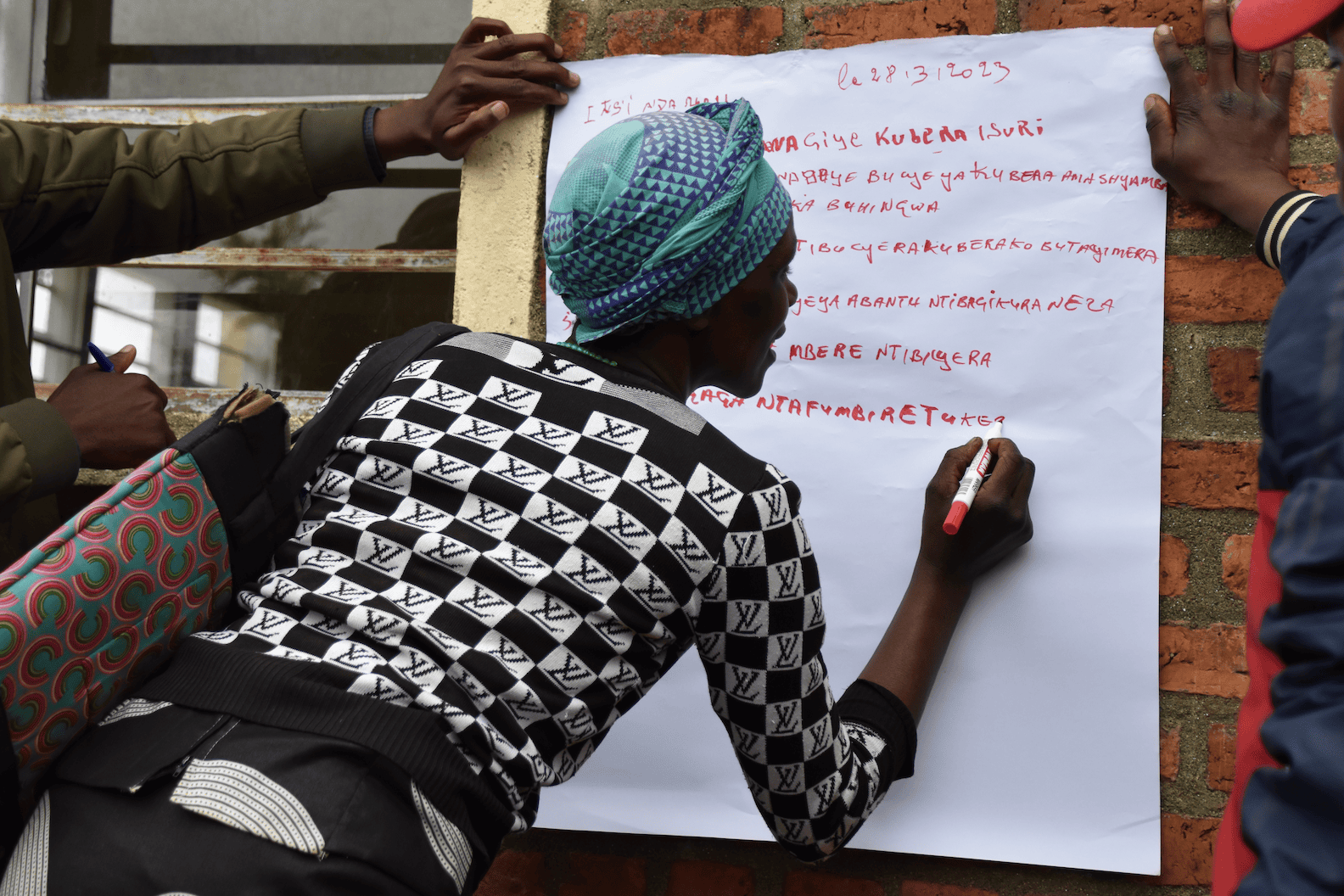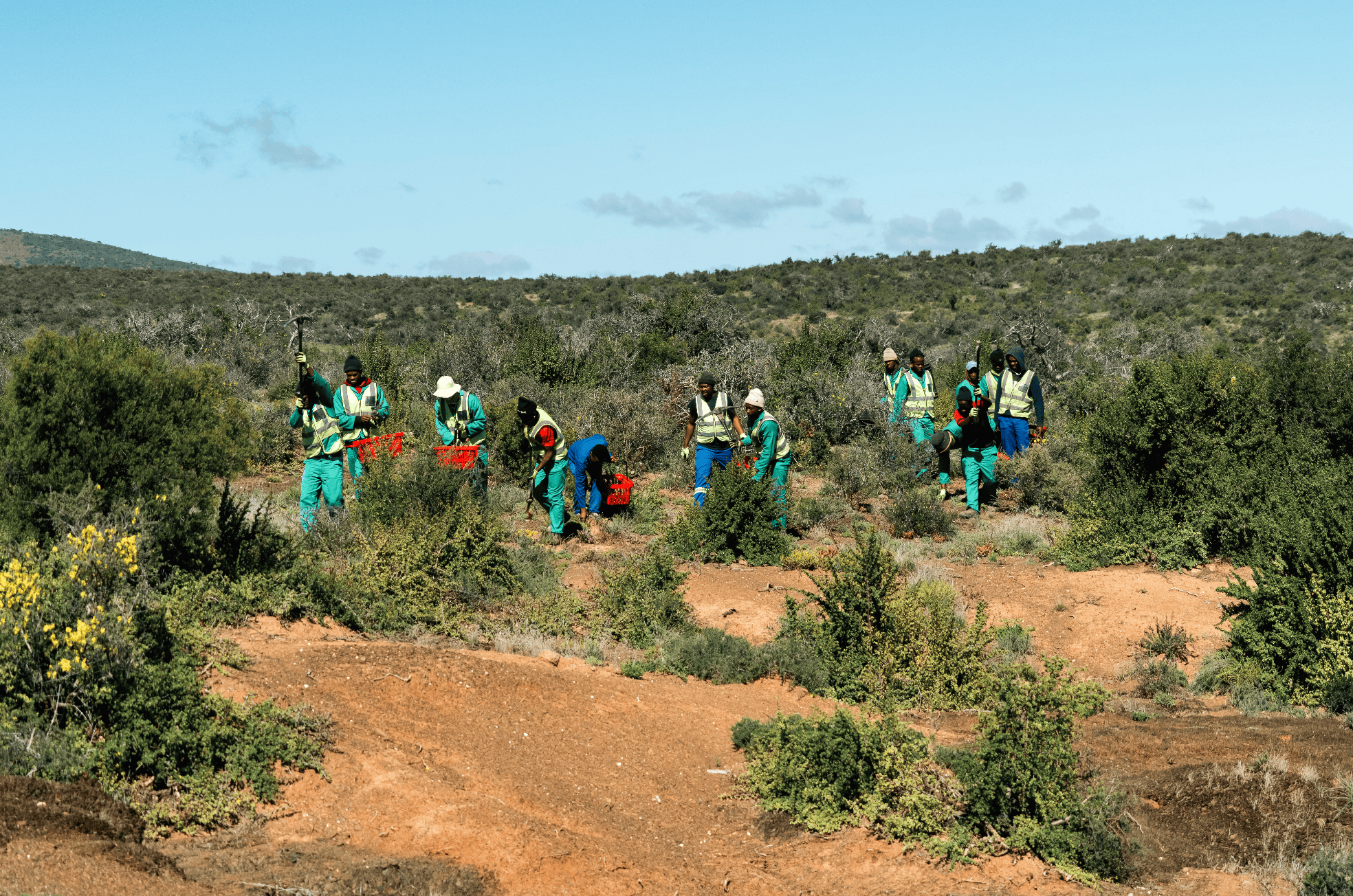While COP 16, held in Colombia in 2024, reiterated the need for monitoring, capacity building and the inclusive participation of indigenous peoples, local communities and women in ecosystem restoration projects, Reforest'Action designs its projects with and for the people who will benefit in the long term, via a structured process of community inclusion and empowerment throughout the life of the projects.

Analyze the socio-economic context before launching the project
Developing a theory of change
Prior to the development of a certified project, Reforest'Action conducts an in-depth analysis of the local context in order to identify salient social and economic issues and how the project might address them over the long term. To do this, we apply the UN's Theory of Change method, which aims to explain how a project is expected to lead to a specific development change through a cause-and-effect analysis based on observed indicators.
Based on the local issues identified, Reforest'Action then selects criteria for assessing the project's impact on biodiversity, climate, the soil-water system and local communities, in order to set priorities in project design from the outset.
Selection and prioritization of socio-economic evaluation criteria
Among these impact assessment criteria, the socio-economic criteria, which directly concern local communities, are grouped into 8 categories and indicate the estimated impact of the project on:
- Agriculture (food safety, food security, food production, support for agriculture)
- Water conservation (water safety, water availability)
- Income generation (direct and indirect income, economic sustainability)
- Education and training (education and awareness-raising for young people and adults, training, contribution to the development of research and innovation)
- Improved living conditions (involvement and empowerment of people, equitable access to social and economic benefits, ensuring decent working conditions, improving the living environment)
- Provision of non-food products (wood, medicinal products, other non-food products)
- Inherent value of the forest (cultural and/or spiritual value, recreational service and/or landscape asset)
- Air quality (freshness of air, reduction of air pollutants and airborne allergens).
Reforest'Action's criteria selection method is specific to each project, and is based in particular on The Road to Restoration reference framework co-published by the WRI and the FAO. Relevant criteria are selected and prioritized according to :
- the project's objectives, in order to steer the project's performance and the achievement of the impacts estimated at the time of its design;
- the project's potential risks, to anticipate and mitigate social and economic risks in particular;
- the needs of the company financing the project, notably in terms of reporting and according to its targeted objectives, linked to its activities and value chains.
- the requirements of certification frameworks, in order to collect the data needed for reporting to international carbon standards.
The example of the Avé Ga project in Togo
The objectives of the Avé Ga project in Togo were defined thanks to an in-depth study of the local context and preliminary consultations with communities, even before the project began. The development of a theory of change enabled Reforest'Action to identify multiple local issues that have a direct impact on local populations.
The project area is faced with environmental problems, particularly due to the reduction in forest cover. This is due to the practice of slash-and-burn farming, as well as unregulated logging for domestic use or resale. These practices lead to soil erosion and degradation of arable land, resulting in lower agricultural productivity and increasingly difficult supplies of firewood and timber for local populations. Added to this is a context of economic and social insecurity, insofar as local sources of employment are limited to traditional agriculture. The villages affected by the project also lack infrastructure, passable roads and limited access to water - all factors that have a direct impact on local livelihoods.
In its preliminary design, the Avé Ga project involves setting up agroforestry systems based on the introduction of fertilizer and fruit trees, in order to reverse the process of soil degradation and establish sustainable, resilient farming systems. In this way, the project is boosting food security for 10,000 families in around 85 villages involved in project activities, and stimulating the local economy by diversifying agricultural production and creating local value chains, generating additional income for local people and developing agricultural cooperatives. In addition, guided by local development committees, each village will be able to select community development projects from a range of activities proposed to them (creation of cooperatives, initiatives to support livestock breeders, etc.). These local projects will contribute to improving their livelihoods.
Villages and communities are thus at the heart of the Avé Ga project. The preliminary design will be validated with local stakeholders during the project preparation phase, prior to the start of operations scheduled for 2026.

Establishing and nurturing a quality dialogue with local communities
Projects designed for and by local communities
As part of the process of certifying projects to an international carbon standard, in particular the Gold Standard, consultation with local stakeholders is mandatory. It consists of identifying and including the communities concerned by the project as early as the preliminary analysis phase, as well as during the project preparation phase.
Stakeholder mapping identifies and categorizes individuals and groups within local communities and indigenous peoples in the project area, so that they can be considered and involved fairly. The aim is to ensure that everyone has a voice and benefits from the project in a way that is adapted to their issues and needs, whether they are influential members of the community or members of vulnerable minorities, for example.
The preliminary stakeholder consultation consists of interviewing a small sample of people from local communities and indigenous peoples. Its aim is to validate and complete the socio-economic issues and needs identified earlier.
Stakeholder consultation aims to open a dialogue with local communities and indigenous peoples to clarify their needs and the issues they face. To this end, group meetings or individual interviews are organized in the field with the various local stakeholders identified (representatives of communities and local authorities, landowners within the project area, local associations and cooperatives linked to the project's objectives). These stakeholders are consulted by Reforest'Action and the Project Implementer to better understand the context, community expectations and needs, and to help improve the project design and results.
The aim of these processes is to ensure that local populations are involved in the project on an equitable basis, so that it can contribute to improving their environment and living conditions over the long term. They must therefore be able to take ownership of the project in a spirit of empowerment, to help make it sustainable and thus continue to benefit from its long-term impacts.
Due diligence and grievance mechanism
A due diligence process is carried out systematically upstream of project development, with the aim of identifying and assessing risks, including man-made risks (such as land-use change), natural risks (such as climate hazards), external risks (such as political instability) and internal risks (such as conflicts between stakeholders involved in the project). This tool ensures stakeholder alignment with environmental and social objectives, and reinforces project sustainability.
The voice of the community is also heard throughout the life of the project. In addition to due diligence, a grievance mechanism has been set up to give communities the opportunity to submit anonymous feedback on project implementation, and to report any problems encountered (discriminatory behavior, harassment, poor working conditions, etc.).
An equitable profit-sharing model
Throughout the life of the project, Reforest'Action's equitable value distribution model ensures that the financial, social and environmental benefits generated accrue to local communities. This approach aims to ensure equity, inclusion and alignment of project impacts with the needs of local stakeholders. The most rigorous carbon standards incorporate these principles into project design criteria.
The example of the MuLaKiLa project in Rwanda
The MuLaKiLa project is one of the largest community restoration projects in Rwanda, supported by a panel of local and international organizations. Founded on the values of solidarity, equity and autonomy, the collective action promoted by this initiative is based on the generation of measurable socio-economic impacts, for the benefit of farming communities in the country's western province.
The project design is based on participatory approaches. To achieve this, it is necessary to take into account the economic and social context of Rwanda and its 13 million inhabitants. The second most densely populated country in Africa, more than half of Rwandans live below the international poverty line of $2.15 a day. Given this situation, the environmental value of the sustainable agricultural practices implemented thanks to the project is not enough on its own to engage the population. This is why the MuLaKiLa project makes social issues a major pillar.
In order to co-construct the project, sharing sessions were organized in March 2023 between teams from Reforest'Action, the local Project Implementer and members of the communities associated with the project. Through focus groups, the idea was to get to know the communities, their way of life, their way of using the landscape, but also to understand the challenges they are currently facing. Transcripts of all the discussions enabled us to draw up a list of the communities' needs and expectations, which were taken into account in the project's design.
For example, the integration of agroforestry, native and fruit species into the crops grown by the region's farmers is a direct response to their need for greater food security. Indeed, restoring land degraded by erosion will restore its fertility, leading to increased productivity.
It's thanks to close work with local communities that the MuLaKiLa project is now accepted, understood and supported locally - an essential dimension to the very sustainability of the project, and to its creation of the expected benefits.

Monitor the project's impact on the local economy and communities
Building a monitoring plan
The construction of a baseline scenario, which determines what would happen in the absence of the project, and the construction of a project scenario, which details the actions to be taken to meet the impact objectives, apply to all impact indicators, which will be scrupulously monitored through a monitoring plan for a minimum of 30 years.
The monitoring plan is a fundamental document that describes data collection procedures, the main impact indicators and the steps involved in monitoring and evaluating the project's performance. It must be based on transparent, scientifically validated methods, cover key indicators of multifunctionality and be capable of adapting to changing conditions to best meet the needs of local communities.
Remote and field impact measurement
Throughout the life of the project, the aim is to ensure that the expected impacts occur as predicted, and that the baselines guiding these estimates remain valid. A combination of field protocols, remote sensing and geomatic tools is needed to monitor the stability and health of ecosystems and the impact of the project on the environment (biodiversity, climate, soil and water), while remote data collection and on-site interviews help to assess the impact of the project on local communities.
The socio-economic data collected remotely by Reforest'Action aims to track the number of project beneficiaries, the percentage of women in this population, the number of training courses provided to communities, the number of jobs created and the level of additional income generated. These “performance” indicators are common to many projects, and meet the reporting needs of contributors wishing to highlight the project's overall socio-economic impact.
These remotely acquired data are enriched by field missions carried out by Reforest'Action, during which the populations concerned by the project are consulted via individual or group interviews (focus groups) to monitor the evolution of the project's socio-economic impacts. The information gathered during these interviews is both quantitative (income levels of the communities concerned by the project in relation to the country's median income, volume of annual harvests, etc.) and qualitative (beneficiaries' satisfaction with the project and its design, match between the project's contributions and the needs of the populations, etc.). They complement the impact assessment by providing details on the integration of the project and how it responds to the socio-economic issues identified.
Recommendations to improve the project's socio-economic benefits can be made by Reforest'Action throughout the life of the project when a gap or weakness is identified. Adaptive management measures can also be implemented to optimize socio-economic benefits.
The example of the Kuzuko project in South Africa
The Kuzuko project, which aims to restore over 5,000 hectares of degraded former grazing land to allow the native biodiversity of these ecosystems to return, is an example of how a project certified by an international carbon standard can improve the living conditions of human communities.
The project is located in a South African province with a poverty rate of 48% and an average unemployment rate of 45%, where the majority of the population depends on seasonal or temporary work. In some rural communities close to the project site, the unemployment rate is as high as 85%.
The deployment of the Kuzuko project employed over 300 people, dedicated to the various implementation activities. Because these workers come from isolated communities up to 70 kilometers from the project area, high-quality infrastructure has been set up near the Kuzuko reserve to provide them with free accommodation and catering, thus avoiding long journeys between their homes and the project area. These workers are paid double the South African minimum wage. They also receive training as part of the project, enabling them to be re-employed on future projects by the local partner or other players. Impact is measured in terms of the number of people benefiting from job creation and the associated wages, as well as the training provided to workers.
The social benefits of the Kuzuko project also extend to the younger generation, as the project is funding two elementary school close to the reserve, which were in danger of closing before the project was set up due to a lack of funds. Today, the funds will be used to restore the dilapidated buildings and improve infrastructure, including the construction of wells and rainwater tanks, and to provide schoolchildren with quality learning materials such as books and computers. The funds donated to these schools thanks to the project will thus help change the life trajectory of schoolchildren by helping to teach them, from an early age, the value of natural ecosystems and biodiversity.

Local communities and indigenous peoples are at the heart of the projects developed by Reforest'Action, which aim to improve their quality of life and the sustainability of their production and ecosystems. Their involvement, right from the project design phase, is therefore essential to ensure that the restoration activities implemented are in harmony with the local socio-economic landscape, and provide appropriate and sustainable benefits to the populations concerned, far beyond carbon sequestration alone.
Reforest'Action also offers a socio-economic impact monitoring approach for all types of forest and agroforestry ecosystems, and for all types of project, whether or not certified by an international carbon standard. Eventually, these results will be reported within our MRV platform dedicated to project financiers, to provide them with key performance indicators and impact data, facilitating investment monitoring and reporting required by certification frameworks such as the CSRD.
Are you a company looking to invest in Nature-based Solutions and benefit from a tool that enables you to demonstrate the socio-economic impacts generated by these projects? Contact one of our experts to discuss your needs.